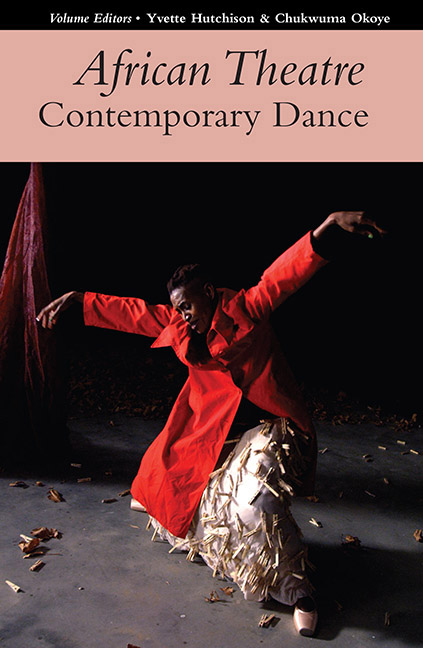Book contents
- Frontmatter
- Contents
- Notes on Contributors
- Introduction
- I Dance
- James Mweu & Kunja Dance Theatre Contemporary dance as African cultural production
- Looking Behind the Mirror Challenging representationalism in contemporary dance in postcolonial African contexts
- Decolonising the Stage Reflecting on Mamela Nyamza in a Canadian-hosted South African performance festival
- Unmuting South African Citizenship through Integrated/Disability Dance
- From Television to the Streets The rise & rise of dance-based advertising in Nigeria
- Dance Photo Essay ‘Untitled’: FOD Gang's environmental activism
- II Open Section
- Book Reviews
Looking Behind the Mirror Challenging representationalism in contemporary dance in postcolonial African contexts
from I - Dance
Published online by Cambridge University Press: 26 July 2019
- Frontmatter
- Contents
- Notes on Contributors
- Introduction
- I Dance
- James Mweu & Kunja Dance Theatre Contemporary dance as African cultural production
- Looking Behind the Mirror Challenging representationalism in contemporary dance in postcolonial African contexts
- Decolonising the Stage Reflecting on Mamela Nyamza in a Canadian-hosted South African performance festival
- Unmuting South African Citizenship through Integrated/Disability Dance
- From Television to the Streets The rise & rise of dance-based advertising in Nigeria
- Dance Photo Essay ‘Untitled’: FOD Gang's environmental activism
- II Open Section
- Book Reviews
Summary
This article offers some thoughts on the conceptual challenges of making, performing and thinking about contemporary dance in Africa, specifically the role of representation and representationalism. It draws on Karen Barad's image of two facing mirrors to argue that, within a representationalist frame, choreographic processes may not only re-craft colonially scripted representations of dancing bodies, but also keep dancing bodies and danced texts locked within a ‘representationalist trap’ (Barad 2003). It asks how we explore ‘What is contemporary dance in Africa?’ outside the space between the mirrors? Does this involve looking behind, under or over the mirrors, inverting or eliminating them? It explores these questions by analysing two specific works of contemporary South African practitioners Mamela Nyamza and Tossie van Tonder.
Problematising the term ‘contemporary dance’
The term ‘contemporary dance’ gives rise to a particular problem when thinking through dance in postcolonial African contexts. Part of the dilemma for those working with contemporary dance in Africa is the continual need to renegotiate the Euro-American roots, dominance and influence of contemporary dance while responding to a postcolonial cultural project. Even in a Western dance context, Bojana Cvejic notes that the term ‘contemporary dance’ ‘entails a vague and undetermined concept’ (2015: 5). Contemporary dance, she writes
serves merely to distinguish the present-day production of dance from the coexisting historical or canonical styles of – originally West- European – theater dance (ballet, ‘classical dance,’ also referred to as ‘academic dance’), or from other non-Western dance traditions as well as dance forms geared to non-art purposes (social, therapeutic, entertainment, etc.) (5)
This description is helpful in placing the term ‘contemporary dance’ in the sphere of theatre dance, but it also complicates the understanding of this term in the context of artistic practice in Africa by distinguishing contemporary dance production from non-Western dance traditions, affirming a discourse in which contemporary dance can only be conceptualised in close relation to a canon of Western theatre dance. Recognising this conceptual problem, this article specifically offers a critique of representation and representationalism with the aim of opening up an investigation into alternative conceptualisations of contemporary dance in postcolonial African contexts that may constitute ways of seeing an ‘aesthetic logic’ in the many experiments undertaken by choreographers in various parts of Africa.
- Type
- Chapter
- Information
- African Theatre: Contemporary Dance , pp. 23 - 44Publisher: Boydell & BrewerPrint publication year: 2018



